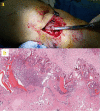Segmental Defect-Bridging Intramedullary Knee Arthrodesis for Osseous Hydatidosis of the Distal Femur: A Case Report
- PMID: 33728208
- PMCID: PMC7955198
- DOI: 10.7759/cureus.13273
Segmental Defect-Bridging Intramedullary Knee Arthrodesis for Osseous Hydatidosis of the Distal Femur: A Case Report
Abstract
Hydatid cyst is a condition endemic to many parts of the world and is mainly caused by Echinococcus granulosus ( E. granulosus). It rarely affects the bone tissue, with the most commonly impacted sites being the vertebrae and the pelvis. Preoperative diagnosis is challenging and very rarely possible because of its similarities with other pathologies. In this report, we present the case of a 64-year-old patient with osseous hydatidosis of a pathological distal femur fracture. The fracture pattern was not recognized on the initial operation and multiple serial debridements were required to control the disease, leading to a large bone defect and a weakened extensor mechanism. A knee arthrodesis with a segmental defect-bridging intramedullary system was eventually performed, which led to satisfying outcomes. Osseous hydatidosis very often presents itself as a pathological fracture and is difficult to diagnose preoperatively with plain radiographs. Orthopedic surgeons are advised to maintain a high index of suspicion and to test for this disease when cystic bone lesions are detected at fracture sites, especially in patients from endemic regions.
Keywords: femur fracture; hydatid cyst; knee arthrodesis; osseous hydatidosis.
Copyright © 2021, Veizi et al.
Conflict of interest statement
The authors have declared that no competing interests exist.
Figures






Similar articles
-
An Unusual Cause of Knee Mass: Osseous Hydatidosis.Cureus. 2021 Oct 6;13(10):e18556. doi: 10.7759/cureus.18556. eCollection 2021 Oct. Cureus. 2021. PMID: 34765341 Free PMC article.
-
Osseous Hydatidosis of Femur in a Patient with Fracture Non-union: An Uncommon Entity.J Clin Diagn Res. 2016 Dec;10(12):ED06-ED08. doi: 10.7860/JCDR/2016/23610.9097. Epub 2016 Dec 1. J Clin Diagn Res. 2016. PMID: 28208867 Free PMC article.
-
Osseous hydatid disease: A mimic of other skeletal pathologies.Radiol Case Rep. 2023 Jun 26;18(9):3145-3151. doi: 10.1016/j.radcr.2023.06.022. eCollection 2023 Sep. Radiol Case Rep. 2023. PMID: 37409101 Free PMC article.
-
Hydatid cyst of bone: diagnosis and treatment.World J Surg. 2001 Jan;25(1):75-82. doi: 10.1007/s002680020010. World J Surg. 2001. PMID: 11213159 Review.
-
Composite treatment for primary long-bone hydatidosis.Orthopedics. 2012 Dec;35(12):e1826-31. doi: 10.3928/01477447-20121120-34. Orthopedics. 2012. PMID: 23218646 Review.
Cited by
-
Management of Pathologic Hip Fracture Secondary to Musculoskeletal Echinococcosis: A Case Report.Cureus. 2024 Sep 25;16(9):e70195. doi: 10.7759/cureus.70195. eCollection 2024 Sep. Cureus. 2024. PMID: 39463664 Free PMC article.
References
-
- Extensive hydatidosis of the femur and pelvis with pathological fracture: a case report. Siwach R, Singh R, Kadian VK, Singh Z, Jain M, Madan H, Singh S. Int J Infect Dis. 2009;13:0. - PubMed
-
- Hydatidosis: dynamics of transmission. Bourée P. World J Surg. 2001;25:4–9. - PubMed
-
- Hydatid bone disease of the pelvis. A report of two cases and review of the literature. Agarwal S, Shah A, Kadhi SK, Rooney RJ. https://pubmed.ncbi.nlm.nih.gov/1611754/ Clin Orthop Relat Res. 1992;280:251–255. - PubMed
-
- Treatment challenges associated with bone echinococcosis. Steinmetz S, Racloz G, Stern R, et al. J Antimicrob Chemother. 2014;69:821–826. - PubMed
Publication types
LinkOut - more resources
Full Text Sources
Other Literature Sources
